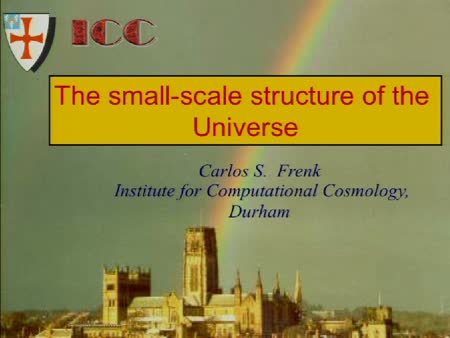Found 24 talks width keyword fundamental physics

Thursday February 19, 2009
Institute for Computational Cosmology, Physics Dept, Durham University
Abstract
The standard model of cosmology -- the ``Lambda cold dark matter'' model -- is based on the idea that the dark matter is a collisionless elementary particle, probably a supersymmetric particle. This model (which mostly dates back to an early workshop in Santa Barbara in the 1980s) has been famously verified by observations of the cosmic microwave background radiation and the large-scale distribution of galaxies. However, the model has yet to be tested conclusively on the small scales appropriate to most astronomical objects, such as galaxies and clusters. I will review our current understanding of the distribution of dark matter on small scales which derives largely from large cosmological N-body simulations and I will discuss prospects for detecting dark matter, either through its gravitational effect on galaxies and clusters or, more directly, through gamma-ray annihilation radiation.
Tuesday November 18, 2008
Max Planck Institute for Astrophysics, Germany
Abstract
The amount of baryons seen in the local Universe falls short by a factor2-5 if compared to the amount of detected baryons at intermediate (z~2)or high (z~1,100) redshift. This is the so called "missing baryon" problem in Cosmology. Hydrodynamical simulations of the large scale structure predict that most of those missing baryons should be in the form of ionized gas present in slightly overdense regions, at a temperature ranging from 10^5 to 10^7 K, conforming the "Warm Hot Intergalactic Medium" (WHIM). This WHIM would not form stars, and would not emit or absorb either in the IR, optical or UV. However, it should interact with the photons of the Cosmic Microwave Background (CMB) through two different channels: (i) Thompson scattering (where there is no energy exchange) and (ii) Compton scattering (where hot electrons transfer energy to the CMB photons, distorting their black body spectrum). I shall review the status of the search for missing baryons in the context of CMB observations and the currently most favored cosmological model. I shall also outline new methods and prospects for detecting this missing gas with upcoming CMB experiments and address the link between the cosmic baryon problem and the search for (so far undetected) bulk flows at scales of ~10 Mpc/h.
Thursday November 13, 2008
Max-Planck Institut für Astrophysik, Garching, Germany
Abstract
In our now-standard picture for the growth of structure, dark matter halos are the basic unit of nonlinear structure in the present Universe. I will report results from simulations of galaxy-scale dark halos with more than an order of magnitude better mass resolution than any previously published work. Tests demonstrate detailed convergence for (sub)structures well below a millionth the mass of the final system. Even with such resolution the fraction of halo mass in bound subhalos does not rise above a few percent within the half-mass radius. I will also present a new simulation technique which allows structure in the dark matter distribution to be studied on very much smaller scales. This is required for accurate forecasts of the expected signal both in earth-bound experiments designed to detect dark matter directly, and in indirect detection experiments like GLAST which attempt to image dark matter annihilation radiation at gamma-ray wavelengths.
Wednesday October 1, 2008
Instituto de Astrofísica de Canarias, Spain
Abstract
Since its discovery in 1964, the cosmic microwave background (CMB) has been one of the basic pillars of the cosmological model. However, it is only very recently that CMB observations have become one of the most powerful tools in modern cosmology, due to the increasing accuracy of the experiments measuring the CMB anisotropies. In this talk, I will present a brief historical perspective of the history of the CMB observations, since the discovery until nowadays, with special emphasis on the implications and the impact of those observations in cosmology. Experiments like COBE, Tenerife, WMAP or PLANCK will be described. The last part of my talk will be devoted to describe the future of this field, and in particular, will be focused on the possibility of the detection of primordial gravitational-waves.<< First « Newer 1 | 2 | 3 Older »
Upcoming talks
- Classical Be stars - Constraining binary interaction physics in massive starsDr. Julia BodensteinerThursday April 25, 2024 - 10:30 GMT+1 (Aula)
- Runaway O and Be stars found using Gaia DR3, new stellar bow shocks and search for binariesMar Carretero CastrilloTuesday April 30, 2024 - 12:30 GMT+1 (Aula)








